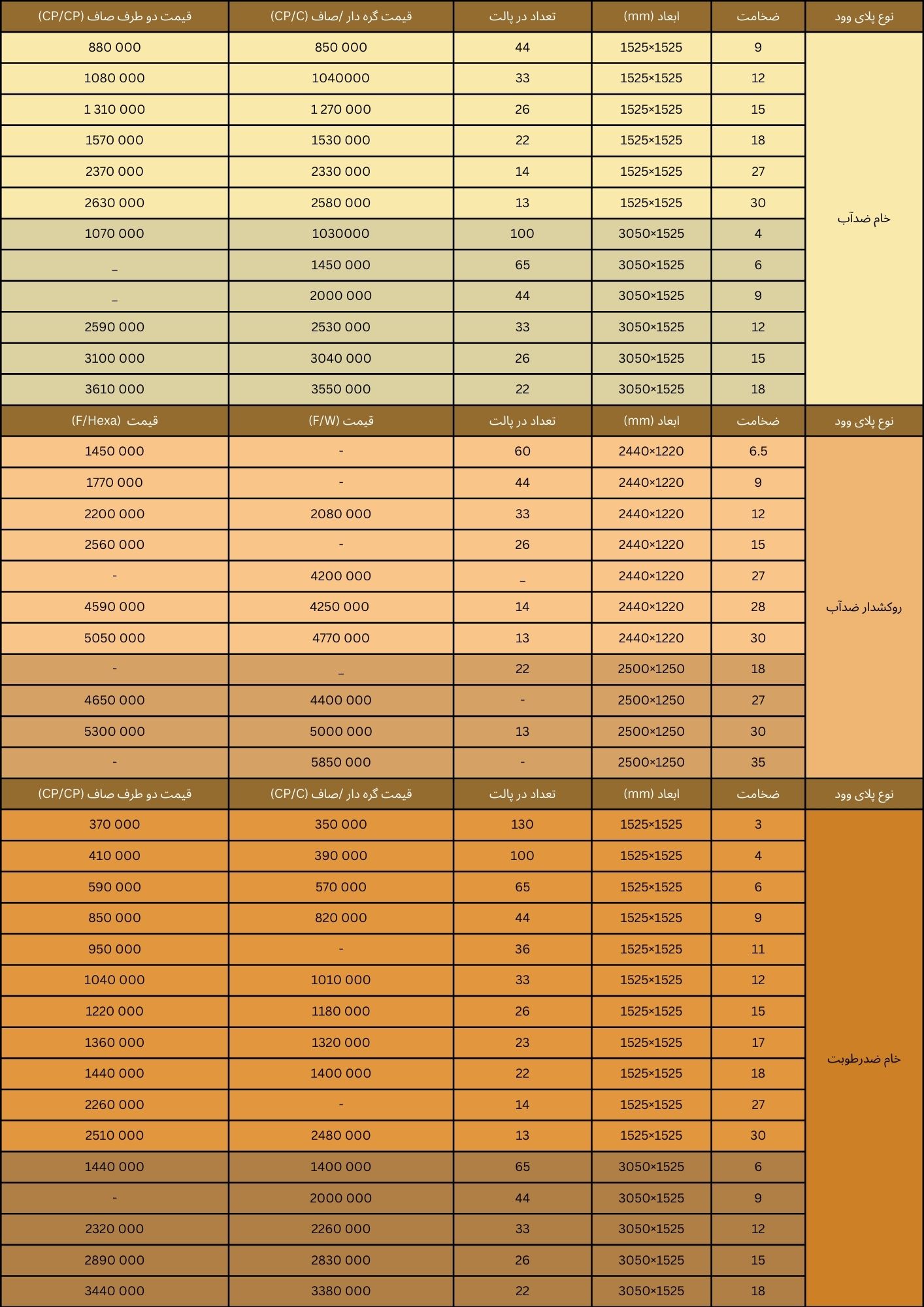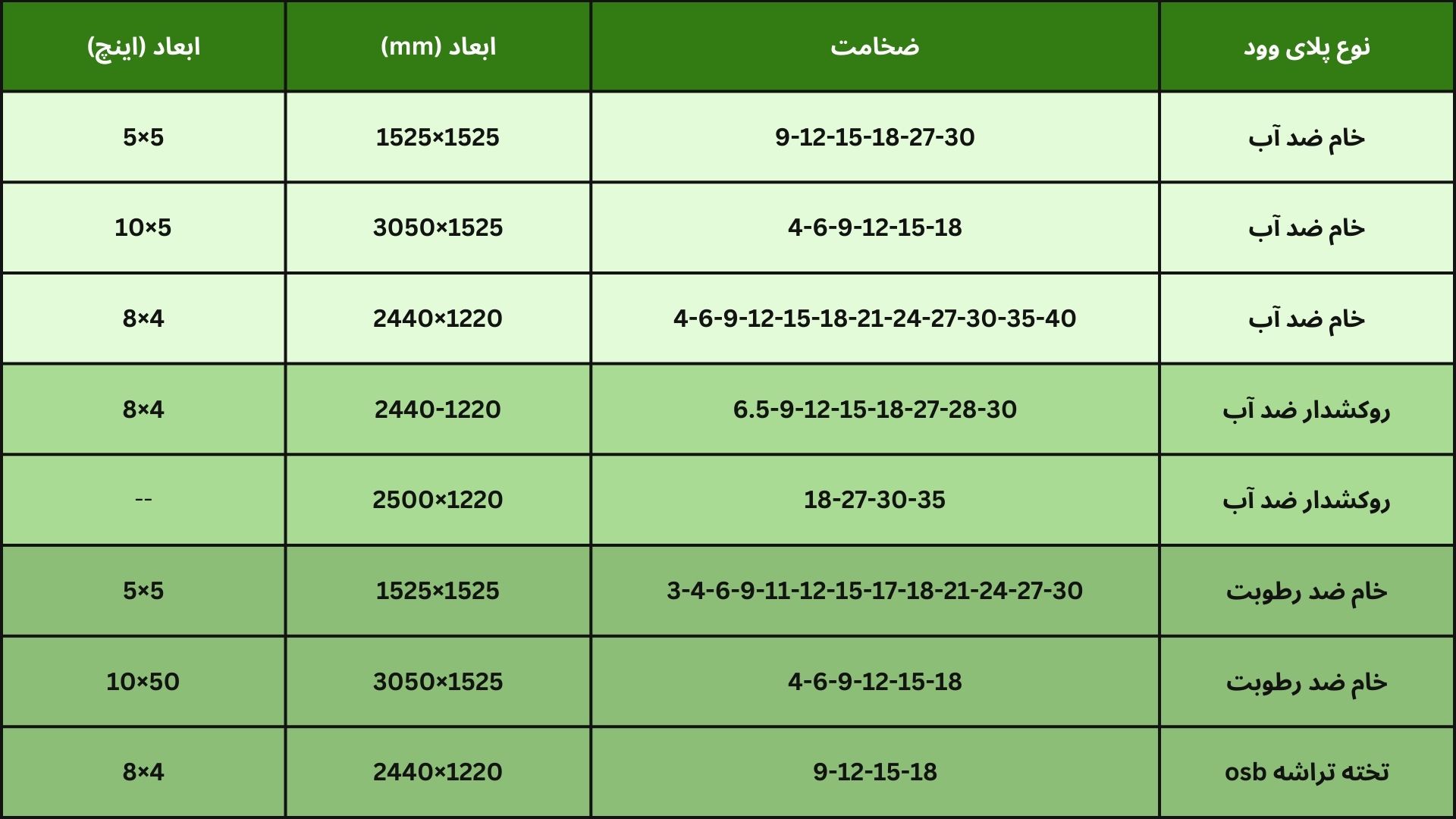پلای وود چیست؟
پلای وود (plywood)، که در فارسی با نام تخته چندلایه نیز شناخته می شود، یکی از پرکاربرد ترین و محبوب ترین محصولات چوبی در جهان است. این محصول به صورت ورق هایی تولید می شود که از ترکیب چندین لایه نازک چوبی به نام روکش به دست می آیند. روکش ها با چسب های مقاوم و با کیفیت به صورت قطعه قطعه روی یکدیگر چسبانده می شوند. قرارگیری لایه ها به این صورت است که جهت الیاف چوب در هر لایه عمود بر جهت الیاف لایه دیگر است. این ساختار خاص موجب می شود پلای وود چند لایه، در برابر نیرو های مختلف بسیار مقاوم باشد و به همین دلیل یکی از مستحکم ترین و بادوام ترین مواد چوبی موجود در بازار است. همچنین این ویژگی سبب کاهش احتمال ترک خوردگی، تاب برداشتن یا تغییر شکل می شود. همچنین، ورق پلای وود در ضخامت ها و اندازه های مختلف تولید می شود و بسته به نوع چوب مورد استفاده در ساخت آن، به دو دسته کلی تقسیم می شود که در ادامه به معرفی آن می پردازیم.
یکی از ویژگی های مهم تخته چندلایه یا پلای وود، سهولت استفاده و کاربری آن است. این محصول به راحتی برش می خورد، سوراخ می شود و می توان آن را با ابزارهای مختلف پردازش کرد. همچنین سطح صاف و یکنواخت آن، امکان رنگ آمیزی، لمینیت یا روکش کاری را فراهم می کند که این مسئله در تولید محصولات تزئینی و لوکس بسیار مهم است. وزن سبک پلای وود نیز یکی دیگر از مزایای مهم آن است که جابه جایی و نصب آن را ساده تر می کند. علاوه بر این، پلای وود به دلیل دوام بالا و طول عمر زیاد، گزینه ای اقتصادی و مقرون به صرفه برای پروژه های مختلف محسوب می شود. این ویژگی به ویژه در پروژه هایی که به مواد مستحکم، مقاوم و در عین حال زیبا نیاز دارند، بسیار اهمیت دارد. پلای وود در صنایع مختلفی، از جمله در ساخت و ساز، تولید مبلمان، دکوراسیون داخلی، کابینت سازی، کف سازی، دیوار پوش ها و حتی صنایع پیشرفته مانند خودرو سازی، هوافضا و…کاربرد دارد. همچنین می توان پلای وود را با انواع روکش های تزئینی، مانند روکش چوب طبیعی یا لمینت، تولید کرد تا در فضاهای داخلی ظاهری زیبا و عالی داشته باشد.
قیمت پلای وود
قیمت تخته چند لایه یا همان قیمت پلای وود به عوامل متعددی بستگی دارد و در بازار تحت تأثیر شرایط مختلفی قرار می گیرد. یکی از عوامل اصلی تأثیرگذار بر قیمت تخته پلای وود، نوع چوب به کار رفته در ساخت آن است. به عنوان مثال، تخته هایی که از چوب سخت مانند بلوط یا گردو ساخته شده اند، معمولاً قیمت بالاتری دارند، چراکه این چوب ها مقاومت و دوام بیشتری دارند. از طرف دیگر، تخته هایی که با چوب نرم مانند کاج یا صنوبر تولید می شوند، به دلیل هزینه کمتر مواد اولیه، ارزان تر هستند.
ضخامت و ابعاد تخته نیز یکی دیگر از عوامل تعیین کننده قیمت تخته چند لایه است. تخته های با ضخامت بیشتر به دلیل استفاده از مواد اولیه بیشتر، قیمت بالاتری دارند. همچنین، تخته هایی با ابعاد بزرگ تر به دلیل قابلیت پوشش دهی وسیع تر، معمولاً گران تر هستند. نوع چسب استفاده شده در تولید پلای وود نیز تأثیر قابل توجهی بر قیمت آن دارد. برای مثال، تخته های تولید شده با چسب های مقاوم به آب و رطوبت، که برای استفاده در محیط های خارجی و مرطوب مناسب هستند، معمولاً قیمت بالاتری نسبت به تخته های استاندارد دارند. یکی دیگر از عوامل مؤثر بر قیمت این تخته چوب چند لایه، برند تولیدکننده و کشور سازنده است. در ادامه جدولی از قیمت انواعی پلای وود (به صورت تقریبی) برای شما آورده شده است. لازم به ذکر است این قیمت ها متغییر بوده و بر اساس معیار های مختلف تغییر می کند.
جهت اطلاع از قیمت روز تخته چند لایه و ورق پلای وود با شماره های 68110-021 و یا 68120000-021 تماس حاصل کنید.
خرید تخته چند لایه پلای وود
مزایای خرید اینترنتی پلای وود
امروزه با پیشرفت تکنولوژی و توسعه فروشگاه های اینترنتی، خرید آنلاین پلای وود به یکی از ساده ترین و کار آمد ترین روش ها تبدیل شده است. برخی از مزایای این روش عبارتند از:
- صرفه جویی در زمان و هزینه: دیگر نیازی نیست وقت زیادی را برای بازدید از فروشگاه های مختلف صرف کنید. با چند کلیک می توانید تخته مورد نیاز خود را انتخاب و خریداری کنید.
- تنوع محصولات: فروشگاه های آنلاین معمولاً مجموعه ای گسترده از انواع تخته چند لایه را ارائه می دهند، که شامل برند ها و کیفیت های مختلف است.
- مقایسه قیمت ها: شما می توانید قیمت ها را بین فروشندگان مختلف مقایسه کرده و بهترین گزینه را انتخاب کنید.
- دسترسی آسان به اطلاعات: مشخصات فنی هر محصول، مانند ضخامت، جنس، و کاربرد، در سایت های فروش موجود است. این اطلاعات به شما کمک می کند تصمیم بهتری بگیرید.
نکات مهم در خرید تخته چند لایه
هنگام خرید تخته چند لایه، توجه به چند نکته اساسی اهمیت دارد:
- کیفیت و برند محصول: اطمینان حاصل کنید که تخته از مواد اولیه با کیفیت تولید شده باشد.
- ابعاد و ضخامت مناسب: بسته به استفاده که دارید، باید ضخامت و اندازه مناسب را انتخاب کنید.
- قیمت: همیشه محصولی را انتخاب کنید که علاوه بر قیمت مناسب، کیفیت خوبی نیز داشته باشد.
چگونه سفارش پلای وود خود را در پلای مارکت ثبت کنیم؟
برای ثبت سفارش تخته پلای وود آنلاین مراحل زیر را دنبال کنید:
- بررسی مشخصات محصولات: توضیحات فنی هر محصول را مطالعه کنید و مطمئن شوید که نیازهای شما را برآورده می کند.
- اضافه کردن به سبد خرید: محصول مورد نظر خود را به سبد خرید اضافه کنید و فرم سفارش را نیز پر کنید.
- پرداخت آنلاین: پرداخت امن از طریق درگاه های بانکی انجام دهید.
- دریافت محصول درب منزل: پس از ثبت سفارش، تخته چند لایه به آدرس شما ارسال می شود.
مزایای خرید از پلای مارکت
- ارسال سریع به تهران: اگر در تهران هستید، می توانید سفارش خود را تنها در یک روز کاری دریافت کنید. این ویژگی برای پروژه های فوری و زمان بر بسیار کاربردی است.
- تنوع محصولات: پلای مارکت مجموعه ای گسترده از انواع پلای وود را با مشخصات مختلف در اختیار شما قرار می دهد تا مطابق با نیاز خود انتخاب کنید.
- امکان خرید حضوری: اگر میخواهید محصولات را از نزدیک ببینید، پلای مارکت امکان خرید حضوری را نیز برای مشتریان فراهم کرده است. کافی است به آدرس زیر مراجعه کنید:
[کیلومتر 12 جاده قدیم کرج (فتح)، ابتدای جاده شهریار، شهرک صنعتی گلگون، خیابان پنجم شمالی، پلاک 8 و پلاک 22
خیابان ششم شمالی پلاک 21]
همچنین برای هماهنگی و اطلاعات بیشتر می توانید با شماره زیر تماس بگیرید:
[021-68110 – 021-68120000]
ضخامت و ابعاد پلای وود
ضخامت پلای وود به تعداد لایه های چوبی استفاده شده در ساخت آن بستگی دارد. رایج ترین ضخامت ها عبارتند از:
- 3 تا 6 میلی متر: برای کارهای ظریف تر مانند روکش ها، لوازم تزئینی و پروژه های هنری مناسب است.
- 8 تا 12 میلی متر: معمولاً در ساخت کابینت، دیوارپوش ها و مبلمان کاربرد دارد.
- 15 تا 18 میلی متر: مناسب برای پروژه های سنگین تر مانند کف سازی، ساخت پارتیشن و سازه های قوی تر.
- 20 میلی متر به بالا: در پروژه های صنعتی و سازه های خاص که نیاز به استحکام بالاتری دارند استفاده می شود.
ابعاد پلای وود
تخته های چند لایه در ابعاد مختلف تولید می شوند تا برای نیازهای متنوع کارآمد باشند. رایج ترین ابعاد عبارتند از:
- 120×240 سانتی متر: این اندازه استاندارد پلای وود است که در بسیاری از پروژه های ساختمانی و دکوراسیون استفاده می شود.
- 122×244 سانتی متر: کمی بزرگ تر از اندازه استاندارد، برای پروژه هایی که نیاز به تخته های وسیع تری دارند.
- سفارشی: برخی از تولیدکنندگان امکان سفارش پلای وود در ابعاد خاص را ارائه می دهند که برای پروژه های خاص یا منحصر به فرد مناسب
در ادامه جدولی از سایز و ضخامت انواع تخته پلای وود آورده شده است که در پلای مارکت قابل خریداری است:
انتخاب ضخامت و ابعاد پلای وود اهمیت زیادی در کیفیت و دوام پروژه شما دارد. با در نظر گرفتن نوع کاربرد، استحکام مورد نیاز و بودجه، می توانید از میان طیف گسترده ای از گزینه ها، بهترین را انتخاب کنید. در فروشگاه هایی مانند پلای مارکت، انواع ضخامت و ابعاد با جزئیات کامل توضیح داده شده است تا انتخاب شما را آسان تر کند. برای اطلاع دقیق تر از ابعاد و موجودی تخته های پلای وود با شماره های زیر تماس حاصل فرمایید.
فروش تخته چند لایه در تهران
اگر به دنبال خرید تخته چند لایه در تهران هستید، پیدا کردن محصولی با کیفیت و مناسب برای حوزه شما اهمیت زیادی دارد. تخته چند لایه، یا همان پلای وود، به دلیل ویژگی های خاص خود مانند مقاومت در برابر رطوبت، استحکام بالا، و قابلیت برش آسان، در صنایع مختلف از ساخت و ساز گرفته تا دکوراسیون داخلی و تولید مبلمان بسیار پر کاربرد است.
فروش تخته پلای وود در تهران
یکی از دغدغه های مشتریان در شهر تهران، دسترسی سریع به تخته های چند لایه با کیفیت بالا و قیمت مناسب است. فروش تخته پلای وود در تهران از طریق فروشگاه های تخصصی مانند پلای مارکت امکان پذیر است. پلای مارکت مجموعه ای متنوع از تخته چند لایه را در ضخامت ها و ابعاد مختلف ارائه می دهد، که می تواند نیازهای مختلف مشتریان را پوشش دهد. اگر سفارش خود را از پلای مارکت ثبت کنید، محصول شما ظرف یک روز کاری به دستتان خواهد رسید. این ویژگی برای پروژه های فوری بسیار کاربردی است. اگر ترجیح می دهید محصولات را از نزدیک بررسی کنید، می توانید به آدرس زیر مراجعه کنید: [کیلومتر 12 جاده قدیم کرج (فتح)، ابتدای جاده شهریار، شهرک صنعتی گلگون، خیابان پنجم شمالی، پلاک 8 و پلاک 22
خیابان ششم شمالی پلاک 21]
همچنین برای هماهنگی و اطلاعات بیشتر می توانید با شماره زیر تماس بگیرید:
[021-68110 – 021-68120000] در نهایت، پلای وود به دلیل ترکیب ویژگی هایی همچون استحکام، پایداری، زیبایی، وزن سبک و سازگاری با محیط زیست، یکی از پرتقاضا ترین و پر استفاده ترین مواد اولیه در پروژه های مختلف صنعتی، تجاری و خانگی محسوب می شود. این تخته چندلایه به طور کامل توانسته جایگاه خود را به عنوان یکی از مصالح پیشرو در دنیای مدرن تثبیت کند و به انتخاب اول بسیاری از طراحان، معماران و مهندسان تبدیل شود.



